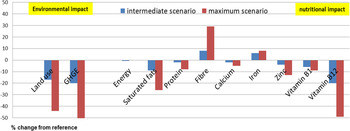Food has a considerable environmental impact. Diets with less meat and dairy reduce the load on the environment but may give nutritional challenges. Risk groups for inadequate micronutrient intakes include children. In a modeling study, we estimated the load of various dietary patterns on environmental aspects as well as on nutritional adequacy.
Energy and nutrient intake and environmental impact (land use and greenhouse gas emission (GHGE)) were assessed for actual consumption patterns (reference scenario) and for two replacement scenarios. In the replacement scenarios, 30% or 100% of meat and dairy foods were randomly replaced by comparable plant-derived foods. Data from the Dutch National Food Consumption Survey in 1267 children aged 2–6 yr (2005–2006) were included and combined with food composition data and environmental loads.
Full replacement of meat and dairy foods by plant-derived foods resulted in substantial lower environmental impact (land use and greenhouse gas emission) when compared to the actual situation (see figure 1). In children, estimated saturated fatty acids intake was 26% lower and fiber intake 29% higher. After 100% meat and dairy replacement by plant foods, children's mean intakes of calcium, zinc and vitamin B1 decreased with 5–13%, and intake of vitamin B12 with 49%, while intake of iron was 10% higher. Calcium intake was below and vitamin B12 above recommendations in all scenarios for children. In girls aged 4–6 y, 100% meat and dairy replacement resulted in 15% and 20% of children with inadequate intakes for zinc and vitamin B1. Plant derived iron might be less bioavailable than iron from animal derived foods. Replacement of meat and dairy by plant-derived foods is beneficial for the environment and for health by lowering saturated fatty acids intake and by increasing the fibre level. Alertness is needed with respect to adequacy of zinc and vitamin B1 intakes in young girls and with respect to the reduced bioavailability of iron.

Fig. 1. Estimated changes in environmental (evaluated for meat and dairy and replacing foods) and nutritional (evaluated for total diets) impacts after meat and dairy replacements.



